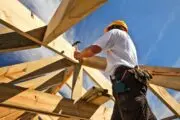Single‐family housing starts increased in July, with a posted rate of 983,000. This figure is 6.7% above the revised June figure of 921,000, according to the U.S. Census Bureau and the Department of Housing and Urban Development.
Privately owned housing starts last month were at a seasonally adjusted annual rate of 1,452,000, which is 3.9% above the revised June estimate of 1,398,000 and 5.9% above the July 2022 rate of 1,371,000. The July rate for units in buildings with five units or more was 460,000.
“Even as average 30-year mortgage rates are pushing up against 7%, single-family starts climbed to the second highest level registered over the past 12 months,” says Nik Scoolis, manager, housing economics, for Zonda. “Start activity is tied closely to sales performance, and builders are expecting the recent strong levels of sales to continue despite the current, seemingly never-ending affordability crunch. The new-home market has been able to provide some relief for buyers through different strategies, including building smaller homes and various incentives.”
Housing units authorized by building permits in July were at a seasonally adjusted annual rate of 1,442,000, which is 0.1% above the revised June rate of 1,441,000 but 13% below the July 2022 rate of 1,658,000. Single‐family authorizations were at a rate of 930,000, or 0.6% above the revised June figure of 924,000. Authorizations of units in buildings with five units or more were at a rate of 464,000.
July’s housing completions were at a seasonally adjusted annual rate of 1,321,000, which is 11.8% below the revised June estimate of 1,498,000 and 5.4% below the July 2022 rate of 1,396,000. Single‐family housing completions were at a rate of 1,018,000, or 1.3% above the revised June rate of 1,005,000. The July rate for units in buildings with five units or more was 297,000.
“We believe the convergence of these three series continues to represent a normalization in residential construction conditions as backlogs clear and demand remains sufficient given the strong labor market and lack of existing homes available for sale,” says Mark Palim, deputy chief economist at Fannie Mae. “Still, we note some downside risk moving forward as home builder sentiment pulled back in August amid a resurgence in mortgage rates back toward 7%.”







